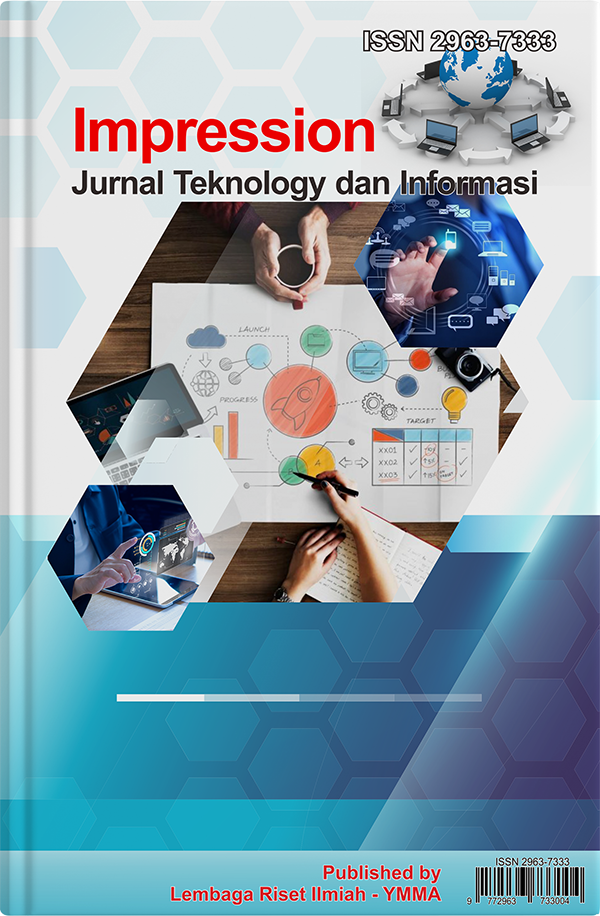Evaluasi Kinerja Antena UWB Cone Es Krim untuk Aplikasi IoT Berbasis 5G melalui Simulasi Pola Radiasi
DOI:
https://doi.org/10.59086/jti.v4i3.1143Keywords:
Antena UWB, Jaringan 5G, Pola radiasi, Kinerja antena UWBAbstract
The rapid advancement of wireless communication technology necessitates efficient antenna systems that support high-speed, low-latency data transmission, particularly for 5G and IoT applications. This research evaluates the two-dimensional (2D) radiation pattern of an ice cream cone-shaped antenna operating at a center frequency of 6 GHz within the Ultra-Wideband (UWB) spectrum. Using MATLAB and a simplified mathematical model, ten radiation pattern variations were simulated based on sine and cosine functions over elevation (θ) and azimuth (φ) angles. The results reveal that patterns such as sin²(θ), |cos(3φ)|, and sin(θ)·cos(θ) provide power distributions suitable for various IoT scenarios, both static and dynamic. Some configurations are particularly effective in multipath or indoor environments with segmented coverage. The symmetrical and omnidirectional radiation performance of the cone design supports consistent connectivity across directions. Additionally, its geometric structure allows practical fabrication and tuning for specific frequencies. Overall, the ice cream cone antenna demonstrates strong potential for modern communication systems requiring broad coverage and energy efficiency. These findings serve as a foundational reference for future physical design and real-world implementation of UWB antennas in 5G and IoT networks.
References
S. Ismail et al., “An Analysis of Width Feedline of Ice Cream Cone Antenna in 5G Technology for Internet of Things (IoT) Applications,” in 2023 International Conference on Information Technology (ICIT), IEEE, Aug. 2023, pp. 599–603. doi: 10.1109/ICIT58056.2023.10226016.
A. H. Hasanudin et al., “Internet of Things - Enabled Stress Surveillance When Pandemic Lockdown: Revolutionizing Resilience,” in 2023 International Conference on Information Technology (ICIT), IEEE, Aug. 2023, pp. 604–608. doi: 10.1109/ICIT58056.2023.10225973.
S. Arora, S. Sharma, and R. Anand, “Ultra-Wideband Antenna with Quintuple Band Notches Integrated with Metamaterials,” Progress In Electromagnetics Research M, vol. 122, pp. 41–52, 2023, doi: 10.2528/PIERM23090601.
I. Roza, Y. T. Nugraha, R. Rida, M. Irwanto, and Mohd. A. Othman, “Modeling of Glugur Substation grounding systems using MATLAB graphical user interface,” International Journal of Electrical and Computer Engineering (IJECE), vol. 15, no. 1, p. 15, Feb. 2025, doi: 10.11591/ijece.v15i1.pp15-23.
Y. T. Nugraha, C. I. Cahyadi, R. Rida, M. S. Ningsih, D. Sholeha, and I. Roza, “Application of the adaptive neuro-fuzzy inference system for prediction of the electrical energy production in Jakarta,” IAES International Journal of Artificial Intelligence (IJ-AI), vol. 14, no. 3, p. 1790, Jun. 2025, doi: 10.11591/ijai.v14.i3.pp1790-1798.
J. Nan, H. Xie, M. Gao, Y. Song, and W. Yang, “Design of UWB Antenna Based on Improved Deep Belief Network and Extreme Learning Machine Surrogate Models,” IEEE Access, vol. 9, pp. 126541–126549, 2021, doi: 10.1109/ACCESS.2021.3111902.
A. Verma, R. K. Arya, R. Bhattacharya, and S. N. Raghava, “Compact PIFA Antenna with High Gain and Low SAR Using AMC for WLAN/C-band/5G Applications,” IETE J Res, vol. 69, no. 7, pp. 4422–4432, Sep. 2023, doi: 10.1080/03772063.2021.1945958.
S. E. Didi, I. Halkhams, M. Fattah, Y. Balboul, S. mazer, and M. El Bekkali, “Design of a microstrip antenna patch with a rectangular slot for 5G applications operating at 28 GHz,” Telkomnika (Telecommunication Computing Electronics and Control), vol. 20, no. 3, pp. 527–536, 2022, doi: 10.12928/TELKOMNIKA.v20i3.23159.
P. Merlin Teresa and G. Umamaheswari, “Compact Slotted Microstrip Antenna for 5G Applications Operating at 28 GHz,” IETE J Res, vol. 68, no. 5, pp. 3778–3785, Sep. 2022, doi: 10.1080/03772063.2020.1779620.
S. B. Kempanna, R. C. Biradar, T. Ali, V. K. Jhunjhunwala, S. Soman, and S. Pathan, “A Compact Slotted UWB Antenna Based on Characteristics Mode Theory for Wireless Applications,” 2023.
Y. Tighilt et al., “Low-Profile UWB-MIMO Antenna System with Enhanced Isolation Using Parasitic Elements and Metamaterial Integration,” 2023.
M. U. Rahman, D. S. Ko, and J. D. Park, “A compact multiple notched ultra-wide band antenna with an analysis of the CSRR-TO-CSRR coupling for portable UWB applications,” Sensors (Switzerland), vol. 17, no. 10, Oct. 2017, doi: 10.3390/s17102174.
V. P. Belichenko, Y. Buyanov, G. Dymov, A. Mironchev, and A. Gorst, “applied sciences Three-Dimensional Ultra-Wideband Antenna : From Guiding Physical Considerations to Sequential Computer Optimization of Parameters and Characteristics,” 2024.
Á. F. Vaquero, “Convex Formulations for Antenna Array Pattern Optimization Through Linear , Quadratic , and Second-Order Cone Programming,” pp. 1–25, 2025.
T. Pisanu et al., “Design , Fabrication , and Electromagnetic Characterization of a Feed Horn of the Linear-Polarized Multi-Beam Cryogenic S-Band Receiver for the Sardinia Radio Telescope,” pp. 1–20, 2025.
B. Yu, P. Zhao, Y. Cai, W. Yuan, J. Yu, and Y. Tan, “On-Site Electrochemical Detection of Corrosion in Substation Grounding System,” Energies (Basel), vol. 17, no. 16, 2024.
F. Ramadhan et al., “Analysis of Characteristics of Three Phase Transformer Using MATLAB,” Jurnal Ecotipe (Electronic, Control, Telecommunication, Information, and Power Engineering), vol. 12, no. 1, pp. 95–102, Apr. 2025, doi: 10.33019/jurnalecotipe.v12i1.4534.
S. S. Bhatia and N. Sharma, “A Compact Wideband Antenna Using Partial Ground Plane with Truncated Corners, L-Shaped Stubs and Inverted T-Shaped Slots,” Progress In Electromagnetics Research M, vol. 97, no. June, pp. 133–144, 2020, doi: 10.2528/PIERM20072503.
M. Irwanto, N. A. E. M. Foze, and Y. T. Nugraha, “Performance Analysis of Transformerless Photovoltaic Three-Phase Inverter Using Sinusoidal Pulse Width Modulation (SPWM) Method,” 2023, pp. 517–527. doi: 10.1007/978-981-19-8406-8_41.
M. Irwanto, Y. T. Nugraha, N. Hussin, I. Nisza, D. Perangin-Angin, and H. Alam, “Modelling of Wireless Power Transfer System Using MATLAB SIMULINK,” 2022 IEEE 13th Control and System Graduate Research Colloquium, ICSGRC 2022 - Conference Proceedings, no. July, pp. 21–24, 2022, doi: 10.1109/ICSGRC55096.2022.9845181.
Downloads
Published
How to Cite
Issue
Section
License
Copyright (c) 2025 Ahmad Arif

This work is licensed under a Creative Commons Attribution 4.0 International License.
Impression Jurnal Teknologi dan Informasi
Publisher Lembaga Riset Ilmiah

This work is licensed under a Creative Commons Attribution 4.0 International License.
Most read articles by the same author(s)
- Muhammad Ikhwan Fahmi, Mhd Fahmi Syawali Rizki, Muhammad Fadlan Siregar, Sri Indah Rezkika, Arif Milando, Ahmad Arif, Zahrul Ulum, Pengujian Saturasi Trafo Arus terhadap Pengaruh Kerja Rele Proteksi , Impression : Jurnal Teknologi dan Informasi : Vol. 4 No. 2 (2025): July 2025













